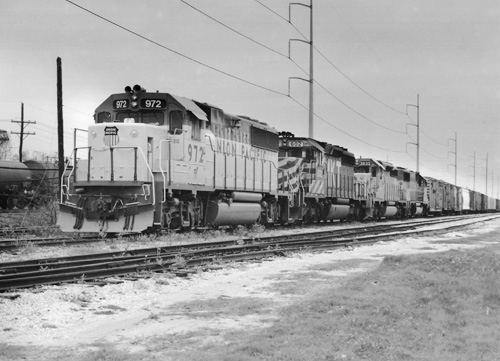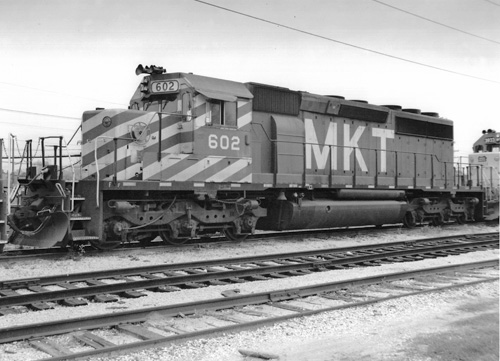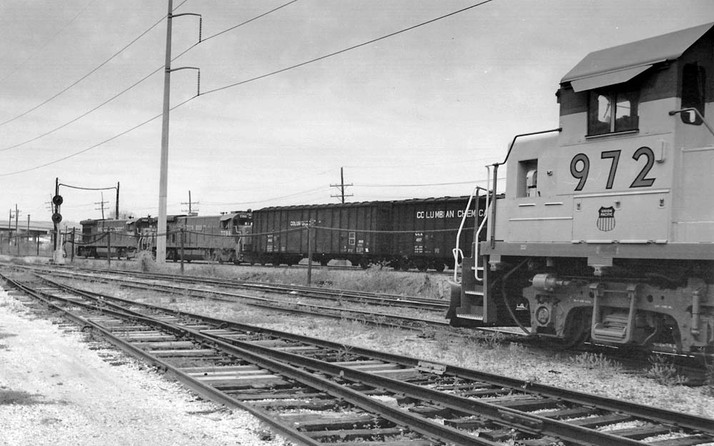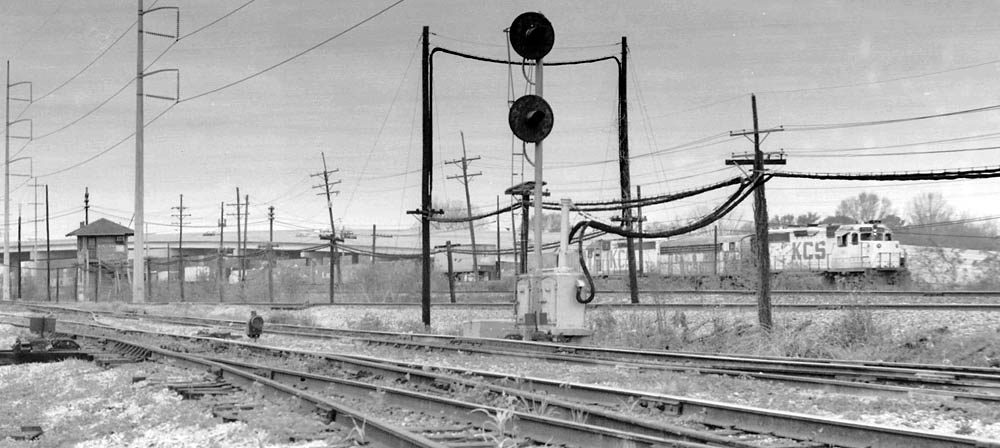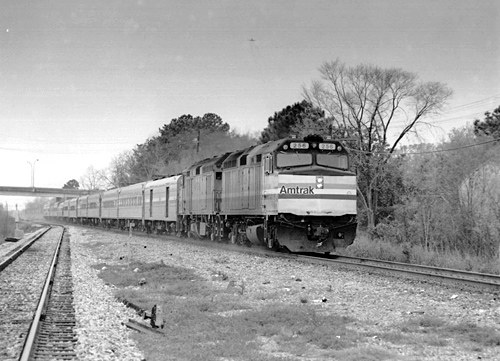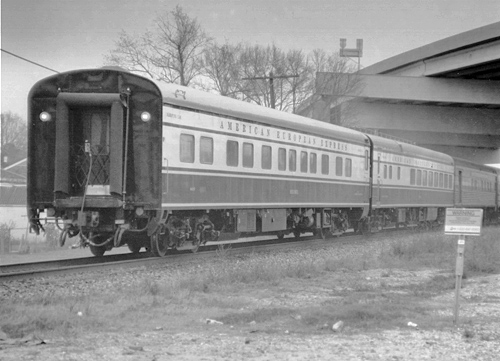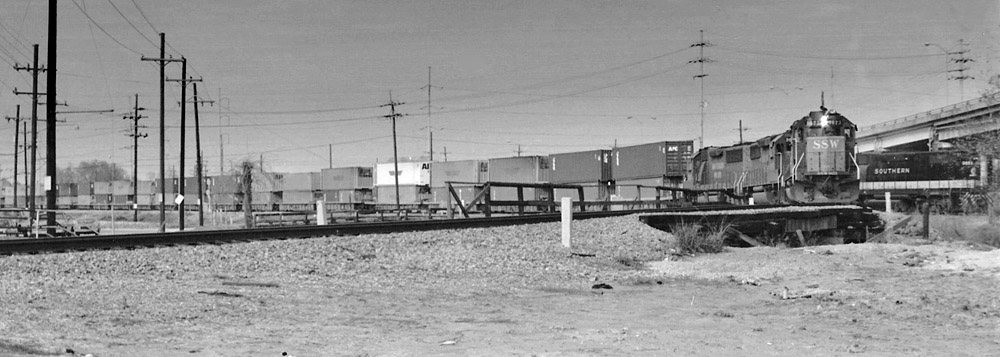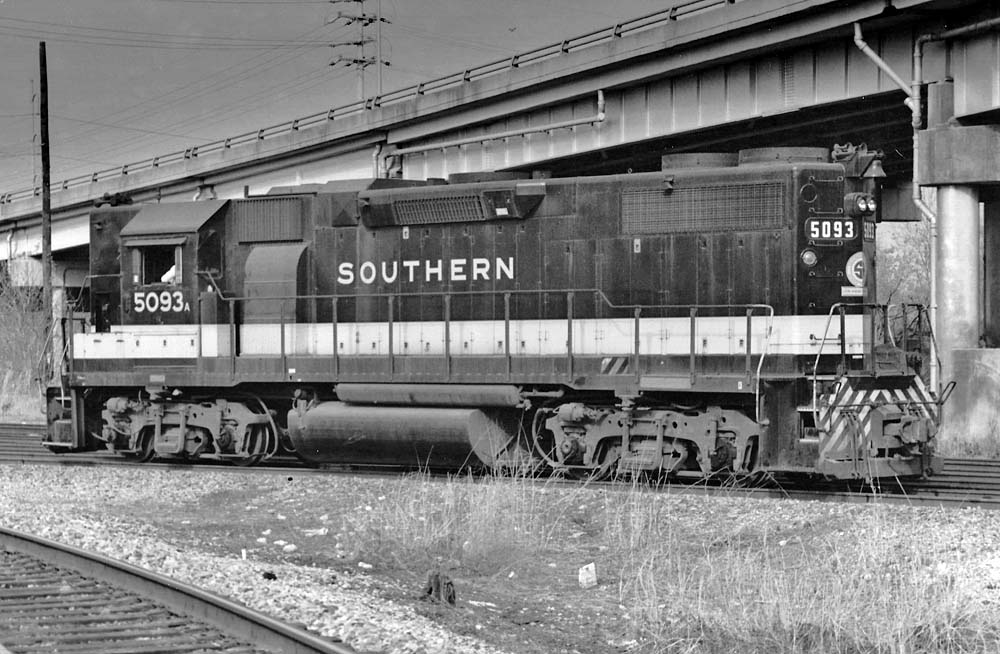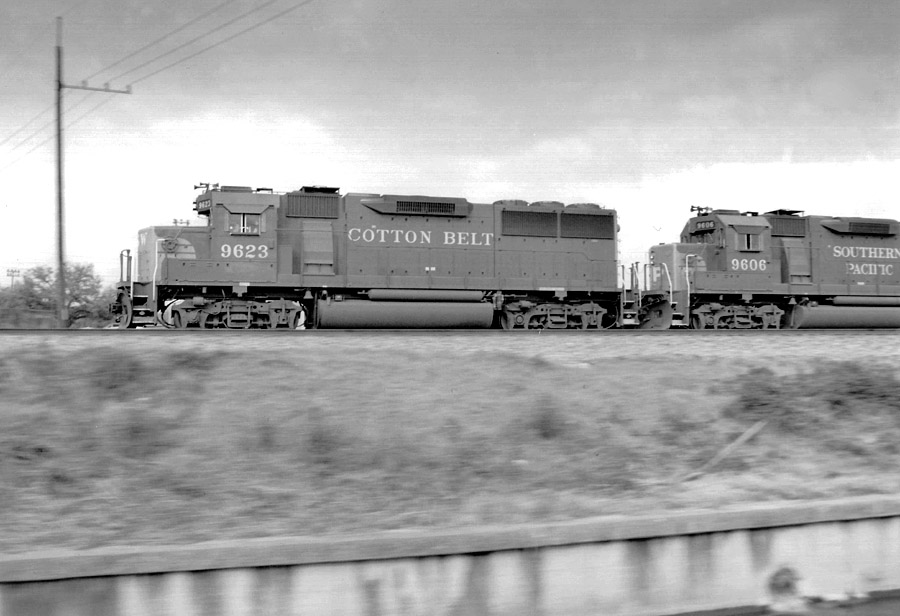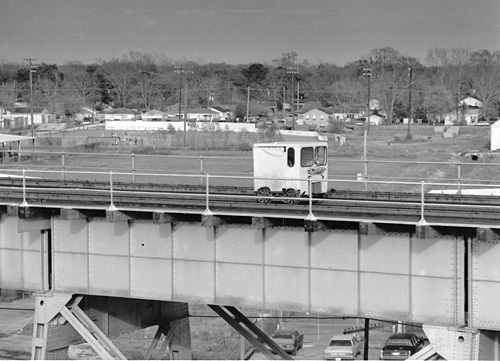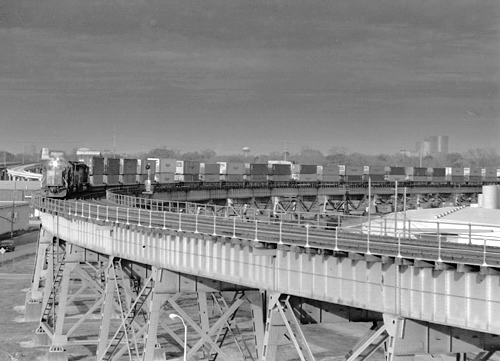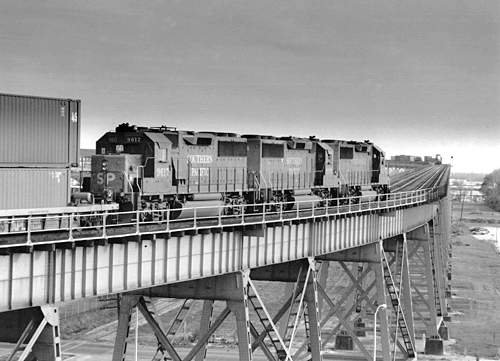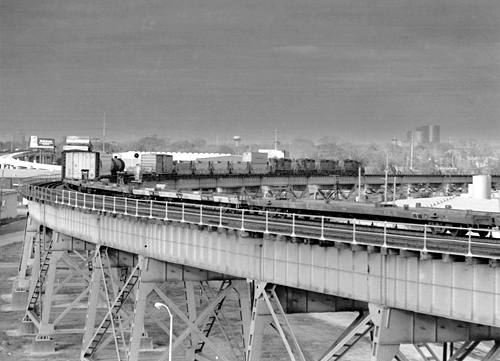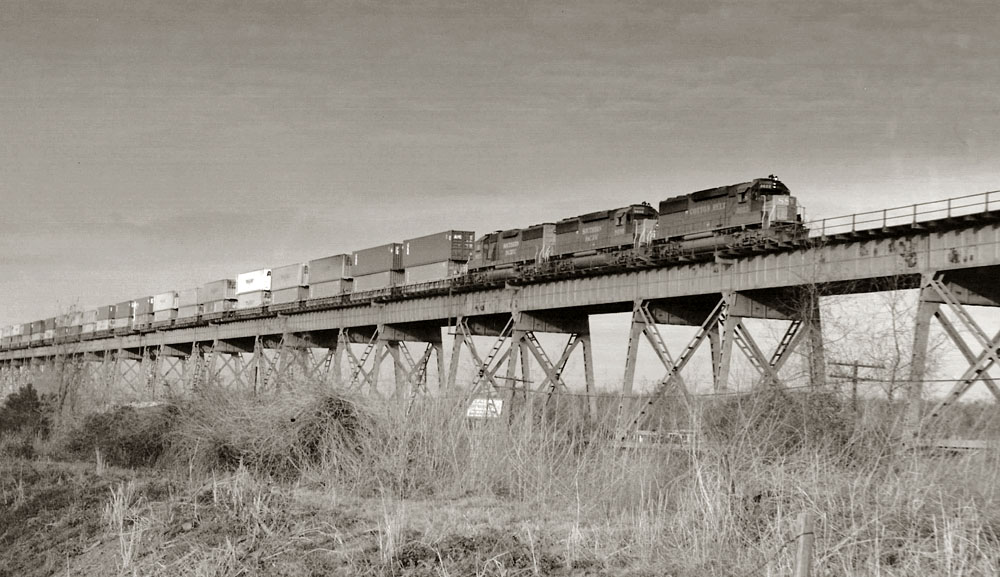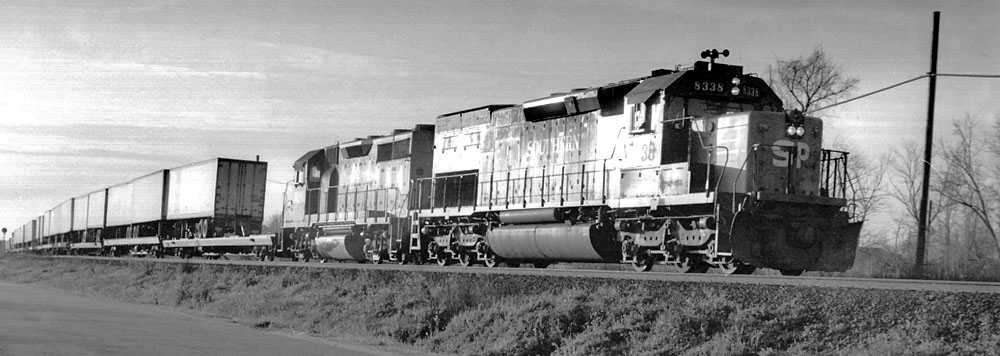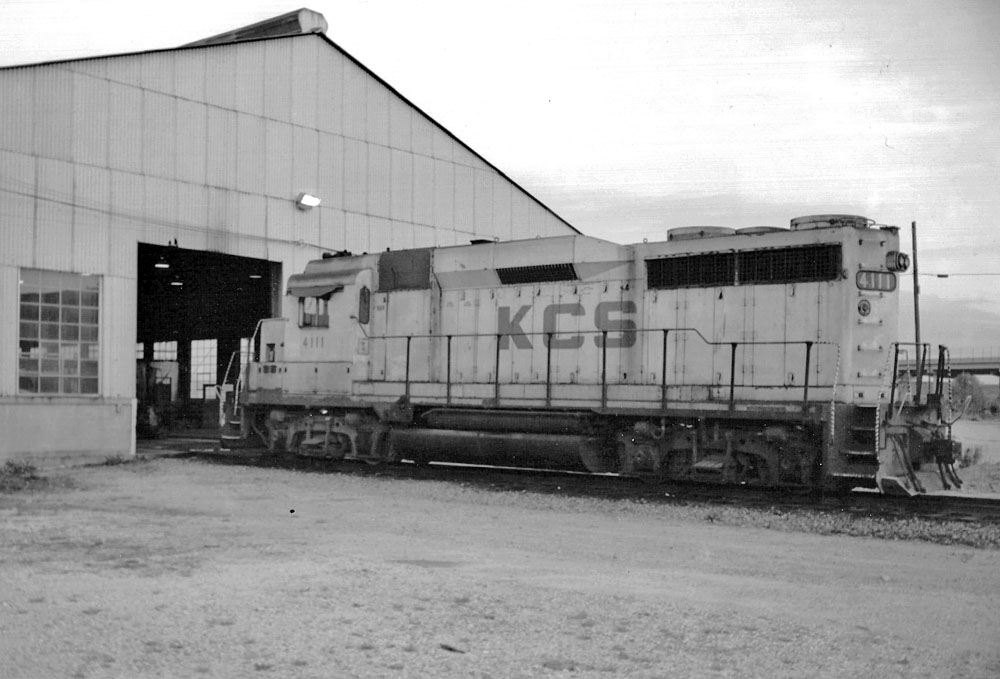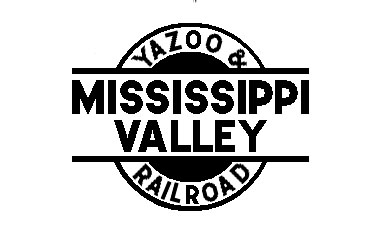A Day in the Big Easy
© 2013 Tom Blackwell
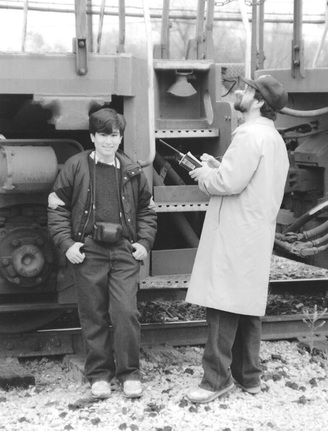 Chris and Mike Palmieri at East Bridge Tower - Mike is checking frame numbers.
Chris and Mike Palmieri at East Bridge Tower - Mike is checking frame numbers.
When most people plan a trip to New Orleans, they think of visiting the usual tourist attractions - the aquarium; the World War II Museum; the unique architecture of the French Quarter; or perhaps take in a Saints game. But railfans know better, of course. They know that the real action in New Orleans takes place not on the synthetic turf of the Superdome, but lies instead on the steel rails that intertwine the city.
When I moved to Louisiana in 1981 I knew that New Orleans was a good railroad town, and I attempted to railfan there. But my attempts proved frustrating. By using maps I could sort of tell where the tracks and yards were, but navigating the city streets was maddening; my few attempts proved less than successful.
Then everything changed - I met Mike Palmieri, who many of you know. Mike is a New Orleans native and a premier railfan; he knew the tracks, streets and rail operations like the back of his hand. He knew what was going on, and where it was going on. Mike and I would get together to railfan New Orleans a number of times over the years; this is the story of one such railfanning adventure, which took place on Saturday, February 25, 1989.
The Friday before had been a gorgeous day, with good sun; the forecast for Saturday was more of the same. But it was not to be - the railfan jinx bit us, as Saturday dawned heavily cloudy, and it would remain that way for most of the day. However, we were undeterred; our plans went forward despite the dismal weather. In deference to the clouds, I decided not to shoot the usual Kodachrome slides, and instead focused (pun intended) on black & white film (digital had not been invented yet). One thing I had been wanting to try was a chromogenic B&W film made by Ilford, so I purchased a couple of rolls and loaded one into the Nikon.
Early on the morning of February 25 Helene and I boarded our 1985 Ramcharger and headed to Mike's house. He was ready and waiting, and joining us today would be Mike's son Chris. Although still a youngster, Chris was as hard core a railfan as any of us. Chris turned out to be one of those rare individuals who was able to parlay his hobby of railfanning into the vocation of a railroad employee; he is currently a manager for BNSF.
When I moved to Louisiana in 1981 I knew that New Orleans was a good railroad town, and I attempted to railfan there. But my attempts proved frustrating. By using maps I could sort of tell where the tracks and yards were, but navigating the city streets was maddening; my few attempts proved less than successful.
Then everything changed - I met Mike Palmieri, who many of you know. Mike is a New Orleans native and a premier railfan; he knew the tracks, streets and rail operations like the back of his hand. He knew what was going on, and where it was going on. Mike and I would get together to railfan New Orleans a number of times over the years; this is the story of one such railfanning adventure, which took place on Saturday, February 25, 1989.
The Friday before had been a gorgeous day, with good sun; the forecast for Saturday was more of the same. But it was not to be - the railfan jinx bit us, as Saturday dawned heavily cloudy, and it would remain that way for most of the day. However, we were undeterred; our plans went forward despite the dismal weather. In deference to the clouds, I decided not to shoot the usual Kodachrome slides, and instead focused (pun intended) on black & white film (digital had not been invented yet). One thing I had been wanting to try was a chromogenic B&W film made by Ilford, so I purchased a couple of rolls and loaded one into the Nikon.
Early on the morning of February 25 Helene and I boarded our 1985 Ramcharger and headed to Mike's house. He was ready and waiting, and joining us today would be Mike's son Chris. Although still a youngster, Chris was as hard core a railfan as any of us. Chris turned out to be one of those rare individuals who was able to parlay his hobby of railfanning into the vocation of a railroad employee; he is currently a manager for BNSF.
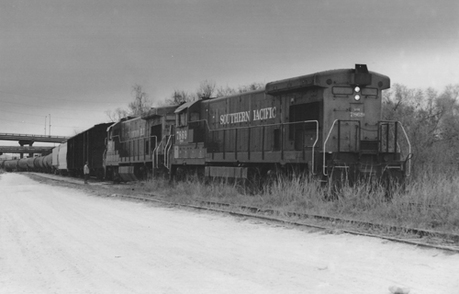 SP 7869 & SSW 7784 on Job 600 at Shrewsbury
SP 7869 & SSW 7784 on Job 600 at Shrewsbury
We all piled into the Ramcharger and headed out, anticipating what the day would bring. I turned over the keys to Mike, since he knew where we needed to go and how to get there; besides, he liked to drive big vehicles with big motors. Mike had heard some scanner chatter concerning SP Job 600 making a pickup at Shrewsbury Junction; this was a transfer job between the KCS in New Orleans and SP's yard across the Mississippi River in Avondale, LA. We motored into Shrewsbury and found the SP crew coupling SP B30-7A 7869 and SSW B30-7A 7784 onto a string of 27 mixed freight cars.
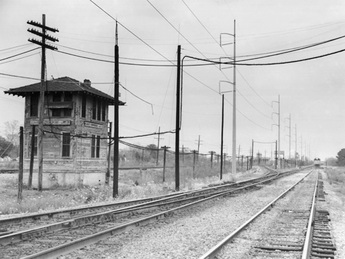 UP AV-16 waiting at East Bridge distant signal.
UP AV-16 waiting at East Bridge distant signal.
We got our pictures at Shrewsbury, and then moved on to that great New Orleans mecca, Central Avenue. Central Avenue lies at the eastern end of the Huey P. Long bridge, which spans the Mississippi River. As such, many of the movements in New Orleans cross Central Avenue. I've found it to be a good place to watch trains, but from a photography standpoint it is a bit tight and cluttered. We pulled into the clear, parked, and took a little stroll to nearby East Bridge Tower. We stayed trackside, as the tower operators frowned upon railfans trying to get inside the tower to visit.
Before we even got to the tower, we spotted a headlight in the distance. It belonged to UP "AV-16", a transfer job which combined traffic from IC's Mays yard and NOPB to cross the river to UP's Avondale yard. It was stopped at a distant signal, and it would remain there for several other movements to clear.
Before we even got to the tower, we spotted a headlight in the distance. It belonged to UP "AV-16", a transfer job which combined traffic from IC's Mays yard and NOPB to cross the river to UP's Avondale yard. It was stopped at a distant signal, and it would remain there for several other movements to clear.
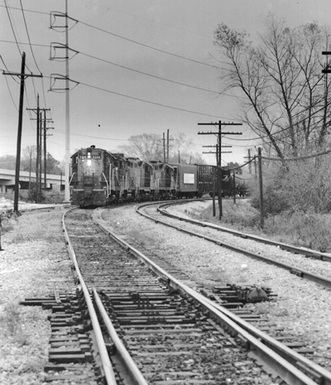 SP transfer from IC's Mays yard to SP's Avondale yard.
SP transfer from IC's Mays yard to SP's Avondale yard.
Soon an SP transfer from IC's Mays yard to Avondale appeared. It had SP GP9E 3384, SSW GP20R 4146, SSW GP9E 3812 and SP GP9E 3317 along with 61 mixed freight cars. While the motors were quite aged at this point in their lives, they were still earning their keep in transfer service.
Meanwhile, UP "AV-16" continued to wait. Next up was a UP transfer from CSX's (L&N) Gentilly yard to UP Avondale. It had CSX GP38-2 2570, UP SD40-2 3179, UP SD40-2 3291, UP B30-7 2489 and UP SD40-2 3508 along with 77 mixed freight cars. AV-16 then moved forward a bit, but stopped at the next signal. It had UP GP50 972, MKT SD40-2 602 (which was smoking rather badly), UP SD40-2 3933 and MP GP50 3508 along with 76 mixed freight cars.
The MKT motor was a treat, as I had seen very few of these.
AV-16 had barely stopped when SP Job 600 (the one we saw at Shrewsbury) rumbled past, making a run at the bridge and Avondale.
Then about ten minutes later, KCS #53 rolled past on its way to CSX's Gentilly yard; it originated in Dallas, and had stopped at Labarre Road in Metairie to pick up a CSX crew. It had KCS GP40 797, KCS road slug 4077 (ex-KCS F7B 59B) and KCS GP40 768 along with 88 mixed freight cars. Why KCS chose to paint their motors white is a great mystery, as they were invariably filthy.
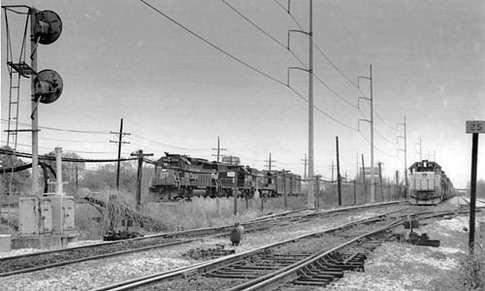 NS #393 roars past UP AV-16 at East Bridge
NS #393 roars past UP AV-16 at East Bridge
At this point there was a break in the action of about thirty minutes. AV-16 was still stuck, so Mike passed the time by recording the locomotive's frame numbers. There would be one last movement before AV-16 finally got on the move. This was Norfolk Southern #393, a Birmingham - SP Avondale run-through train. It had SP GP40-2 7243, NS GP38 2777 and NS U23B 3948 along with 92 mixed freight cars. This seemed a rather paltry exhibition of power for such a premier train. After it cleared, AV-16, having spent much of the morning at East Bridge, finally made a run for the Huey P. Long and Avondale.
Thus for the first time since we arrived at East Bridge some three hours ago, there were no trains visible. Thus we took the short stroll back to Central Avenue. But not to worry. About fifteen minutes later, Amtrak #59, the SB City of New Orleans absolutely roared through, scattering dust and trash everywhere. It was a bit late and I guess the engineer was trying to make up time, but he had very little distance to do it. If an errant motorist had tried to cross Central Avenue in front of #59 (as they seem to all too often do), #59 would have knocked it all the way to Lake Pontchartrain.
As I peered through my viewfinder, I noted that the two trailing cars did not match the rest of the Amfleet equipment. As the train passed, I wheeled around to get a going away view, and discovered that the last two cars belonged to the American - European Express Company. #59 had F40PH's 256 and 272 and 12 cars. Interestingly, the pair of F40's was operating back to back, instead of the usual nose to back.
As I peered through my viewfinder, I noted that the two trailing cars did not match the rest of the Amfleet equipment. As the train passed, I wheeled around to get a going away view, and discovered that the last two cars belonged to the American - European Express Company. #59 had F40PH's 256 and 272 and 12 cars. Interestingly, the pair of F40's was operating back to back, instead of the usual nose to back.
As we watched #59 disappear into the murky gloom, we realized that we were hungry! Well, it was almost 13:30 hours now, and breakfast had been a long time ago, back before daylight. Mike knew the perfect place to eat - the New Orleans Hamburger Factory, which sat in the shadows of the Huey P. Long bridge; the burgers really hit the spot. Only one movement crossed the bridge while we were eating. Mike gleaned from the scanner that it was another SP transfer run from Gentilly yard to Avondale. It had Conrail SD40 6340, DRGW GP40 3052 and SP SD45R 7563 along with 82 mixed freight cars.
As we departed the Hamburger Factory, Mike picked up on another movement that was imminent; NS #219 was approaching NS' Oliver yard on the east side of New Orleans. This was the cause of considerable excitement, as #219 was the hottest intermodal train on NS' eastern lines, having originated at Potomac yard in Alexandria, VA. It would be handed off to SP at Oliver yard to become SP "AVLXT" (Avondale-Los Angeles Trailers). Thus Mike pointed the Ramcharger east, and we motored across town.
As we departed the Hamburger Factory, Mike picked up on another movement that was imminent; NS #219 was approaching NS' Oliver yard on the east side of New Orleans. This was the cause of considerable excitement, as #219 was the hottest intermodal train on NS' eastern lines, having originated at Potomac yard in Alexandria, VA. It would be handed off to SP at Oliver yard to become SP "AVLXT" (Avondale-Los Angeles Trailers). Thus Mike pointed the Ramcharger east, and we motored across town.
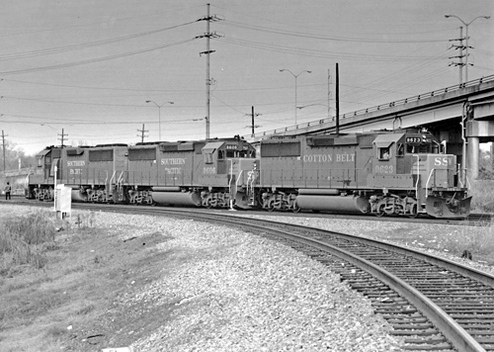 Power for SP "AVLXT" at Oliver Junction.
Power for SP "AVLXT" at Oliver Junction.
Remember back in the old days when the Pony Express recruited the fastest horses and riders to carry the mail cross country? Well, NS and SP assigned their fastest ponies to this train. When we arrived at Oliver yard, we were greeted by the sight of a trio of GP60's - SSW 9623, SP 9606 and SP 9617; SP had already staged the power for "AVLXT".
What unfolded next was quite the spectacle. Within a couple of minutes, NS #219 rolled into view; it consisted of NS GP50's 7036, 7079 and 7081 along with a cut of 55 APL double stacks, plus other TOFC cars on the rear end. The NS power cut off and pulled into the clear.
The SP power backed in and coupled up. Meanwhile, NS cut the TOFC cars off, leaving "AVLXT" with the double stacks The engineer on "AVLXT" made his brake test, and then started pulling; the entire maneuver took well under an hour. This was railroading as it should be done!
What unfolded next was quite the spectacle. Within a couple of minutes, NS #219 rolled into view; it consisted of NS GP50's 7036, 7079 and 7081 along with a cut of 55 APL double stacks, plus other TOFC cars on the rear end. The NS power cut off and pulled into the clear.
The SP power backed in and coupled up. Meanwhile, NS cut the TOFC cars off, leaving "AVLXT" with the double stacks The engineer on "AVLXT" made his brake test, and then started pulling; the entire maneuver took well under an hour. This was railroading as it should be done!
As "AVLXT" began to pull, NS GP38-2 5093 trundled by on adjacent track, still in SOU paint.
We figured that "AVLXT" was well worth chasing. We piled back into the Ramcharger and took off in hot pursuit of the train. We caught up with it shortly, at a point where the tracks and road ran side by side. We rolled down the windows and paced the train, listening to the chant of the prime movers and the song of the turbochargers; it just don't get much better than this (unless, of course, it was steam). Since we were able to stay with the train easily, I decided to try some pacing shots. I backed the shutter speed on the Nikon down to 1/30 second, and hung it and myself out the window, hoping that the road was smooth enough to not jar the camera; the objective was to blur the background, but not the entire image. I fired off a number of frames, and managed to get a couple that were pretty decent; most were not.
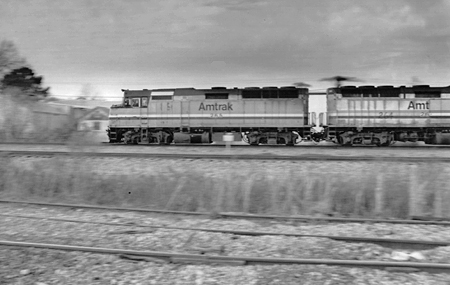 Amtrak #58 gets out of town in a hurry.
Amtrak #58 gets out of town in a hurry.
At some point during the chase (and I don't remember now just when or where), we left "AVLXT" and caught up with Amtrak #58, which was just out of NOUPT. It had consecutively numbered F40PH's, the 265 and 264, along with 11 cars. The road was still beside the tracks, so we paced it for a bit, and since I was still hanging out the window of the Ramcharger, I fired off a few frames of it.
We were still ahead of "AVLXT" at this point, so Mike made a beeline for the parking deck of Elmwood Medical Center; the parking deck was a great place to photograph trains. The upper level was right at eye level with the east approach to the Huey P. Long bridge, and there was a great view in both directions. Best of all was the fact that no one hassled you there. The security guard might (or might not) come up and ask what you were doing, but then left you alone. Unfortunately this hassle-free existence did not last much longer, and Elmwood became off limits to railfans.
We pulled in to Elmwood, drove up to the upper level, and bailed out. Looking to the west, we could see a WB train; it was almost to the superstructure of the bridge, and all that we could tell about it was that it was a mixed freight.
We were still ahead of "AVLXT" at this point, so Mike made a beeline for the parking deck of Elmwood Medical Center; the parking deck was a great place to photograph trains. The upper level was right at eye level with the east approach to the Huey P. Long bridge, and there was a great view in both directions. Best of all was the fact that no one hassled you there. The security guard might (or might not) come up and ask what you were doing, but then left you alone. Unfortunately this hassle-free existence did not last much longer, and Elmwood became off limits to railfans.
We pulled in to Elmwood, drove up to the upper level, and bailed out. Looking to the west, we could see a WB train; it was almost to the superstructure of the bridge, and all that we could tell about it was that it was a mixed freight.
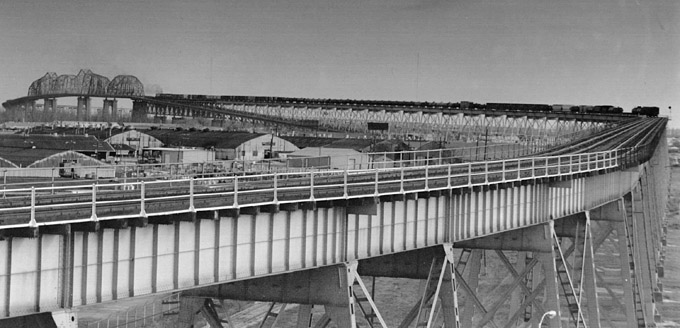 Unidentified WB train on Huey P. Long Bridge.
Unidentified WB train on Huey P. Long Bridge.
We then turned our attention eastward, looking for "AVLXT", but there was no sign of it yet. After a few minutes, we saw something ascending the east approach, but it was not "AVLXT'. Instead, it turned out to be a New Orleans Public Belt speeder, carrying a track inspector. NOPB checks the bridge several times per day, as this is hardly a desirable place to have a derailment. By this time, the sun was actually peeking out, beginning to dispel the gloom that had marred most of the day.
The speeder came and went. After a few more minutes, we spotted a headlight to the east. This time it was "AVLXT", and it made a fine sight climbing the bridge. The three GP60's were really digging in, and they made easy work of the 1.25% grade.
As it passed, we turned westward to follow it, and were pleasantly greeted by the sight of an EB headlight.
The EB move turned out to be SP "HOCXM" (Houston-New Orleans, CSX). It had SP GP9E 3317, SSW GP9E 3812, SSWGP20R 4146 & SP GP9E 3384, along with 45 mixed freight cars.
The EB move turned out to be SP "HOCXM" (Houston-New Orleans, CSX). It had SP GP9E 3317, SSW GP9E 3812, SSWGP20R 4146 & SP GP9E 3384, along with 45 mixed freight cars.
We quickly piled back into the Ramcharger; Mike put the hammer down and headed across the river to Bridge City. If I had not known better, I would have thought we were in some sort of rocket powered vehicle piloted by Evil Knievel as he attempted to leap the Grand Canyon. We screeched to a halt in Bridge City just in time to catch the AVLXT as it descended the bridge, dynamic brakes whining.
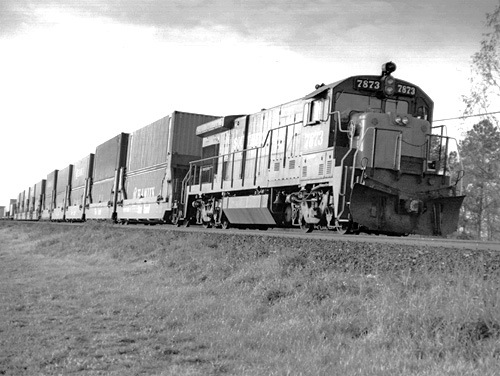 SP "HONOQ" rolls through Avondale.
SP "HONOQ" rolls through Avondale.
We then continued on to Avondale. There we hit the jackpot, catching two SP intermodal trains in the span of about fifteen minutes.
The first was "HONOQ" (Houston-New Orleans, Quality); this was one of what SP called a "sprint" train. It had lone SP B30-7A 7873 along with 34 double stacks and COFC cars. By this time the sun was low in the sky, and provided some nice glint light on the flanks of the train. This train was destined for NS' Oliver yard once it crossed the Mississippi River.
The second train rolled past only ten minutes after "HONOQ". It was "HOCXQ" (Houston-New Orleans, CSX), another sprint train. It had SP SD40T-2 8338 and SSW GP35 6680 (a strange pairing) along with 28 TOFC cars; it was destined for CSX's Gentilly yard.
The first was "HONOQ" (Houston-New Orleans, Quality); this was one of what SP called a "sprint" train. It had lone SP B30-7A 7873 along with 34 double stacks and COFC cars. By this time the sun was low in the sky, and provided some nice glint light on the flanks of the train. This train was destined for NS' Oliver yard once it crossed the Mississippi River.
The second train rolled past only ten minutes after "HONOQ". It was "HOCXQ" (Houston-New Orleans, CSX), another sprint train. It had SP SD40T-2 8338 and SSW GP35 6680 (a strange pairing) along with 28 TOFC cars; it was destined for CSX's Gentilly yard.
By this time the sun was fading fast. We made our way back across the river to New Orleans, and made a pass by KCS' West yard. There we found several KCS motors - SD50 708, SD40 636, NW2 4222, and GP30's 4111, 4109, 4115 and 4104.
The light was
just about gone now, so we gave up on railfanning. We headed back to Mike's
house. Once again the hunger pangs were calling, so we picked up Mike's wife
Pat and younger son Steven and headed for supper. While New Orleans boasts any
number of five star restaurants, we eschewed these in favor of the local
Arby's. Despite the mostly grubby weather, we had had a fine day of railfanning
in the Crescent City.
This article was published in Volume 13 Issue I, Summer 2014 issue the The Crimson Flyer which is the publication of the Southeast Louisiana Chapter of the National Railway Historical Society. Many thanks to Tom Blackwell for putting this day on paper and for allowing it to be posted here!
